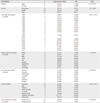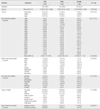Abstract
Purpose
Methods
Results
Figures and Tables
Table 2

*(Number of students' accidental death÷student population)×1,000,000; †Standardized mortality based on elementary (49.27%), middle (26.27%), and high school student (24.46%) population in 2005; ‡(Number of male students' accidental death÷male student population)×1,000,000; §(Number of female students' accidental death÷female student population)×1,000,000; ∥(Number of accidental death among elementary school students÷elementary school student population)×1,000,000; ¶(Number of accidental death among middle school students÷middle school student population)×1,000,000; #(Number of accidental death among high school students÷high school student population)×1,000,000; **(Number of students' accidental death inside school÷student population)×1,000,000; ††(Number of students' accidental death outside school÷student population)×1,000,000.
Table 3

*(Number of students' accidental death÷student population)×1,000,000; †(Number of male students' accidental death÷male student population)×1,000,000; ‡(Number of female students' accidental death÷female student population)×1,000,000; §(Number of elementary school students' accidental death÷elementary school student population)×1,000,000; ∥(Number of middle school students' accidental death÷middle school student population)×1,000,000; ¶(Number of high school students' accidental death÷high school student population)×1,000,000; #(Number of students' accidental death inside school÷student population)×1,000,000; **(Number of students' accidental death outside school÷student population)×1,000,000.
Table 4

*Excluding 4 persons who were not eligible for compensation money; †Adjusting for age and significant covariates with ANOVA, 4 discrete years (1988-1992, 1993-1997, 1998-2002 and 2003-2007), type of death; ‡Adjusting for age, gender, 4 discrete years and type of death; §Adjusting for age, gender, type of death; ∥Adjusting for age, gender, 4 discrete years.




 PDF
PDF ePub
ePub Citation
Citation Print
Print



 XML Download
XML Download